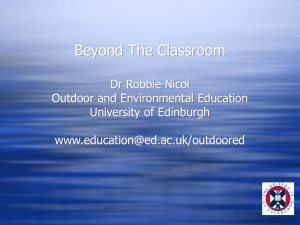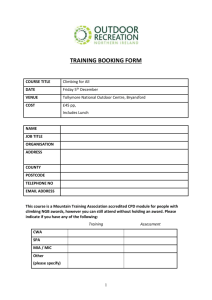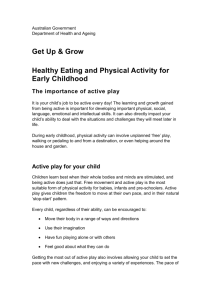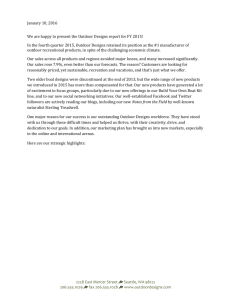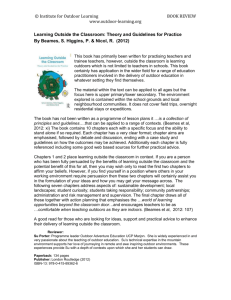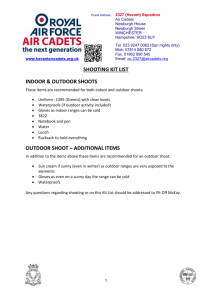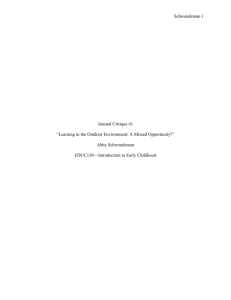OUTDOOR EDUCATION: Scope and sequence of content
advertisement
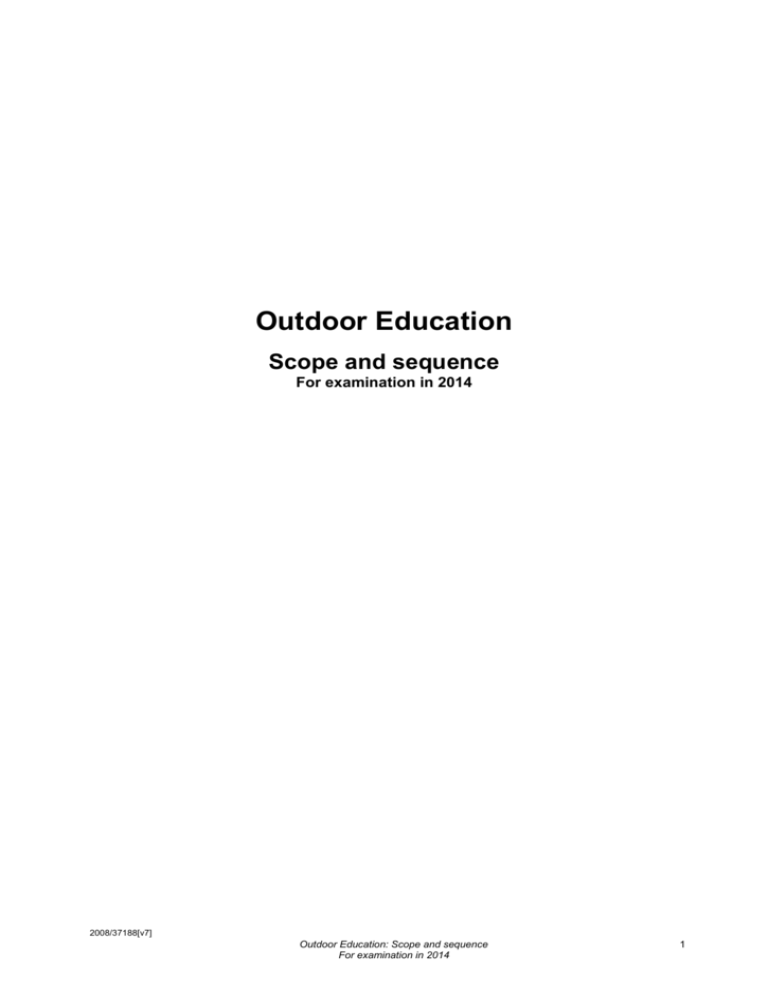
Outdoor Education Scope and sequence For examination in 2014 2008/37188[v7] Outdoor Education: Scope and sequence For examination in 2014 1 Copyright © School Curriculum and Standards Authority, 2008 This document—apart from any third party copyright material contained in it—may be freely copied, or communicated on an intranet, for non-commercial purposes by educational institutions, provided that it is not changed in any way and that the School Curriculum and Standards Authority is acknowledged as the copyright owner. Teachers in schools offering the Western Australian Certificate of Education (WACE) may change the document, provided that the School Curriculum and Standards Authority’s moral rights are not infringed. Copying or communication for any other purpose can be done only within the terms of the Copyright Act or by permission of the Authority. Copying or communication of any third party copyright material contained in this document can be done only within the terms of the Copyright Act or by permission of the copyright owners. Disclaimer Any resources such as texts, websites and so on that may be referred to in this document are provided as examples of resources that teachers can use to support their learning programs. Their inclusion does not imply that they are mandatory or that they are the only resources relevant to the course. 2 Outdoor Education: Scope and sequence For examination in 2014 Outdoor Education—Scope and sequence of content UNIT PA Becoming familiar with the outdoors UNIT PB Being active and confident in the outdoors UNIT 1A Experiencing the outdoors UNIT 1B Facing challenges in the outdoors UNIT 1C Building confidence in the outdoors UNIT 1D Outdoor leadership Outdoor experiences Planning equipment lists for expedition use of available resources to gain knowledge about a local natural environment such as the beach, marine park, bushland conservation reserve and national park. tools used to assist in personal preparation including equipment lists, menu plans and itinerary. aspects of expedition planning to assist in personal preparation pre- and postEuropean history of the area information about features of the natural environment map showing route schedule equipment lists (including first aid kit) menu standard operating procedures minimum impact practices environmental management rules. aspects of expedition planning to assist in personal preparation pre- and postEuropean history of the area features and relationships between parts of the natural environment weather information personal and group goals map showing route schedule fitness preparation equipment lists menu standard operating procedures minimum impact practices relevant environmental management plans of the area fitness preparation for outdoor adventure activity identification of relevant components of fitness fitness goals fitness program design. Outdoor Education: Scope and sequence For examination in 2014 aspects of expedition planning to assist in personal preparation pre- and postEuropean history of the area features and relationships between parts of the natural environment weather forecasting personal and group goals schedule, maps showing route and expedition route cards fitness preparation equipment lists (including first aid kit contents) menu Risk Analysis Management System (RAMS) and subsequent standard operating procedures emergency procedures leadership responsibilities; prior, during and post shared leadership experience minimum impact relevant rules related to the use of the area. aspects of expedition planning to assist in personal preparation pre- and postEuropean history of the area features and relationships between parts of the natural environment weather forecasting personal and group goals schedule fitness preparation expedition route (map and route cards) equipment lists menu risk assessment emergency procedures leadership responsibilities minimum impact relevant rules related to the use of the area. 3 UNIT PA Becoming familiar with the outdoors Skills and practices essential skills in an outdoor activity combine essential skills introduction to maps including definition and characteristics, and drawing simple maps preparing, packing, and storing food in the outdoors selection of an appropriate location to eat. UNIT PB Being active and confident in the outdoors UNIT 1A Experiencing the outdoors essential skills in an outdoor activity combine essential skills introduction to navigation including how a compass works, finding direction and using a map to navigate basic roping skills including tying common knots putting up and using a tent. 4 technique development of a variety of skills in an outdoor adventure activity strategies to improve own performance in an outdoor adventure activity tying common knots reef figure eight bowline clove hitch figure eight on the bight and follow through round turn and two half hitches setting of ropes types and care of ropes roping skills relevant to the outdoor activity, first aid and excursion/expedition types of maps, features of maps, using a map to navigate and introduction to compasses generic expeditioning skills campsite selection shelter construction cooking hygiene water treatment. UNIT 1B Facing challenges in the outdoors technique development of a variety of skills in an outdoor adventure activity apply strategies in response to a range of situations in an outdoor adventure activity roping skills relevant to the outdoor activity, basic outdoor first aid and camping basic skills of navigation: natural indicators of direction, using a map/chart to navigate and feature based navigation. Outdoor Education: Scope and sequence For examination in 2014 UNIT 1C Building confidence in the outdoors technique development of a variety of skills in an outdoor adventure activity strategies to solve problems in an outdoor adventure activity roping skills relevant to the outdoor activity and basic emergency response survival skills to meet basic human requirements combine map/chart and compass skills specific to selected activity construction of simple expedition route cards. UNIT 1D Outdoor leadership technique development of a variety of skills in an outdoor adventure activity implement strategies to solve specific problems in an outdoor adventure activity roping skills relevant to outdoor activity and advanced emergency response position finding through triangulation and practical feature based navigation. UNIT PA Becoming familiar with the outdoors Safety keeping warm, keeping cool, reducing exposure, keeping hydrated and fuelled in the outdoors definition and importance of safety. UNIT PB Being active and confident in the outdoors UNIT 1A Experiencing the outdoors wearing comfortable and suitable clothing behaviours and equipment to increase comfort in the outdoors introduction to risk definition awareness of identification danger. definition and importance of personal comfort safe practices and safety guidelines relevant to outdoor activity equipment and behaviour necessary for personal protection from environmental conditions and hazards related to the activity such as wearing a helmet and seeking shade identification and treatment of common outdoor illnesses/injuries selection and packing of essential first aid equipment including bandages, applications, medication and tools completion of medical forms. UNIT 1B Facing challenges in the outdoors role and importance of risk-taking and challenge in outdoor education definition of risk, adventure, peak experience, challenge, chance, competence, and danger simple risk assessment and management models traffic light Smartmove. UNIT 1C Building confidence in the outdoors Outdoor Education: Scope and sequence For examination in 2014 principles of risk management: identification of hazards, assessment of risk, consideration of social and physiological factors and risk reduction strategies use a Risk Analysis Management System (RAMS) form to assess and manage risk while on expedition key aspects of current outdoor education and recreation activity guidelines in Western Australia Department of Education (DoE) procedures and guidelines Adventure Activity Standards (AAS) steps for emergency response/accident management primary and secondary patient assessment treatment monitoring emergency procedures for expedition group and logistical support. UNIT 1D Outdoor leadership use simple risk assessment and management models for a group while on expedition purpose, construction and completion of accident report forms emergency response: search, rescue and evacuation basic and technological signalling methods used in an emergency response whistle fire sand drawing satellite phones flares emergency position indicator radio beacon (ePIRB) personal locator beacon (PLB) radio introduction to local and national emergency services. 5 UNIT PA Becoming familiar with the outdoors UNIT PB Being active and confident in the outdoors UNIT 1A Experiencing the outdoors UNIT 1B Facing challenges in the outdoors UNIT 1C Building confidence in the outdoors UNIT 1D Outdoor leadership Self and others Personal skills definition of self-concept definition of and awareness of personal skills personal reflection such as recalling events use of a logbook to record events. awareness of individual strengths and weaknesses recalling events and recording thoughts use of a logbook/journal to record events and personal reflection. Working with others definition of communication and ways to communicate effectively developing communication skills including communicating clearly and using active listening. introduction to cooperation and collaboration. definition of selfawareness, selfappraisal, goal setting, time management, flexibility, monitoring, reflection, commitment definition of self-concept and identifying personal strengths and weaknesses entering details of, and reflecting on an experience in a logbook/journal. definition of communication skills, assertion, cooperation, collaboration, problemsolving, and negotiation types of communication skills and active listening characteristics and functions of an effective group. time management and goal setting skills use of a logbook/journal during an outdoor adventure experience and answering debriefing questions afterwards. assertion, cooperation and collaboration skills group goals for an outdoor experience introduction to group dynamics ground rules for effective group operation. 6 Outdoor Education: Scope and sequence For examination in 2014 flexibility and monitoring skills, self-efficacy, selfdetermination and motivation methods of selfreflection journal writing using a questionnaire. problem-solving, decision-making and conflict resolution skills setting group goals responsibility for self and others in a group stages within Tuckman’s model of group development forming storming norming performing adjourning strategies for building effective group relationships/group roles. commitment, tolerance and resilience skills reflective tools used for self-appraisal performance ratings Johari Window self-debrief. conflict management skills evaluation of group performances negotiation strategies for building and maintaining effective groups. UNIT PA Becoming familiar with the outdoors Leadership introduction to leadership: awareness of, definition and function introduction to leadership qualities. UNIT PB Being active and confident in the outdoors UNIT 1A Experiencing the outdoors identification of leadership qualities in others identification of personal leadership qualities. UNIT 1B Facing challenges in the outdoors generic leadership qualities trustworthy/honest fair open instils confidence in others good listener leadership qualities in significant others related to the outdoors such as Sir Edmund Hillary, Steve Irwin and Dian Fossey purpose of and what is contained in an activity briefing. definition of ecological terms ecosystem abiotic biotic trophic levels producers consumers decomposers flows food webs abiotic and biotic features of natural environments within a local natural environment. characteristics of designated, emergent, elected and shared leaders autocratic, democratic and abdicratic leadership styles purpose of an activity debriefing and what is expected of the participants. UNIT 1C Building confidence in the outdoors UNIT 1D Outdoor leadership characteristics of telling, selling, testing, consulting, joining and task vs. people oriented leadership autocratic, democratic and abdicratic leadership styles linking leadership styles to Tuckman’s stages of group development participating in shared experiences in outdoor leadership to lead and facilitate a briefing and debriefing self-reflection on leadership. features and relationships in the natural environment of the expedition area components of weather wind clouds precipitation temperature air pressure identification of local seasonal weather patterns weather forecasting using synoptic charts and climatic averages. leading a briefing and debriefing session appraisal of own and others’ leadership in a debriefing session. Environmental awareness The environment basic knowledge of features of the natural environment of the expedition area introduction to the wind, rain, clouds, and temperature as components of weather local seasonal weather patterns basic weather forecasting using weather maps and climatic averages. identification of local plants and animals using field guides. abiotic and biotic features of a local natural environment relationships between features within a natural environment synoptic charts and what they show. Outdoor Education: Scope and sequence For examination in 2014 features of the natural environment of the expedition area weather forecasting using natural indicators while in the natural environment clouds wind animal behaviour. 7 UNIT PA Becoming familiar with the outdoors Relationships with nature differences between natural and man-made characteristics of nature introduction to ‘Leave No Trace’ principles. UNIT PB Being active and confident in the outdoors UNIT 1A Experiencing the outdoors personal responses to nature developing a relationship with a local natural environment how to reduce impact on the environment every day. definition of nature and natural environments motivations for seeking outdoor experiences characteristics of natural environments that people seek human responses to nature such as fear, appreciation, awe, contemplation introduction to ‘Leave No Trace’ principles. UNIT 1B Facing challenges in the outdoors Environmental management recognition of signs and symbols used to educate people about rules and regulations with using certain local natural environments. rules and regulations associated with using certain local natural environments definition and purpose of national parks and marine parks. 8 WA environmental management departments and other local agencies/organisations DEC (Department of Environment and Conservation) Botanical Parks and Gardens Rottnest Island Authority WA land management classifications national parks conservation parks nature reserves state forests marine parks associated rules, regulations and guidelines for using a managed area for specific outdoor activities. UNIT 1C Building confidence in the outdoors portrayals of nature culturally and in the media personal responses to risk in outdoor experiences role of technology in managing risk language used to describe human– nature relationships acquaintance friend sibling intimate partner ways in which humans value nature application of the ‘Leave No Trace’ principles. introduction to conservation and biodiversity impact of humans on natural environments awareness of strategies used to manage specific environments such as management plans. Outdoor Education: Scope and sequence For examination in 2014 UNIT 1D Outdoor leadership individual, community and large scale effects of natural change changes in the ways humans have valued nature over time commercial, recreational, conservational and human activities that alter places application of ‘Leave No Trace’ principles. definition of sustainability sustainability issues rare and endangered species renewable resources. technology and the environment improvements to equipment electronic equipment the impact of urbanisation and changing lifestyles minimising human impact on nature concept of wilderness application of ‘Leave No Trace’ principles. sustainability projects wetlands sustainability Coastcare Clean Up Australia Day tree planting cave restoration Friends of the Bibbulmun Track snorkel trail restoration responsibility of individuals, communities, governments and industry for the environment. UNIT 2A Being responsible in the outdoors UNIT 2B Attaining independence in the outdoors UNIT 3B Developing and facilitating outdoor experiences UNIT 3A Outdoor program development Outdoor experiences Planning Skills and practices introduction to Maslow’s Hierarchy of Needs physiological needs safety needs love/belonging needs esteem needs self-actualisation relationship between physiological and safety needs (Maslow’s Hierarchy) and personal preparation for outdoor experiences considerations for selecting equipment relevant to expedition area location duration terrain anticipated weather conditions food and fluid requirements. technique development of an increasing repertoire of skills in an outdoor adventure activity map/chart reading skills identifying features interpreting and applying scales using grid references using contour lines taking a bearing travelling on a bearing calculating back bearings and magnetic variation purpose and elements of a simple route plan destination and distances times terrain stages/check points. expedition planning considerations research into expedition area (Aboriginal and European history, flora and fauna, weather data) overview of expedition participant information group and personal SMART goals schedule fitness needs leadership route planning simple risk assessment model minimum impact practices equipment and menu planning considerations for selecting appropriate expedition equipment for specific environments and activities. matching and adjusting skills and techniques in changing situations in an outdoor adventure activity care/maintenance of ropes qualities of an effective knot types of knots related to campcraft/shelter construction reef figure eight bowline clove hitch figure eight on the bight and follow through round turn and two half hitches double fisherman’s applying roping skills to outdoor activities navigational strategies including aiming off and use of attack points and handrails construction and use of detailed expedition route cards which include elevation data and evacuation points. the impact of lower order needs from Maslow’s hierarchy on program development physiological needs safety needs love and belonging needs esteem needs logistical aspects of expedition planning to assist in group preparation budget transport accommodation equipment bookings relevant correspondence communications emergency response support crew. skills, techniques and strategic responses in varied and changing situations in an outdoor adventure activity skills specific to outdoor activity and emergency response use of triangulation to accurately locate position description and function of global positioning systems (GPS). Outdoor Education: Scope and sequence For examination in 2014 elements of outdoor programs with specific foci recreational developmental environmental educational therapeutic/redirectional (at risk) physical spiritual relationship aspects of planning (participant, group, logistic) to assist in preparing to run an effective outdoor experience for a group with a specific focus. matching and adjusting skills, strategies and techniques in changing situations in an outdoor adventure activity. 9 UNIT 2A Being responsible in the outdoors Safety 10 definitions of relevant risk management terminology risk challenge hazards danger misadventure risk management principles of risk management identification of risks causal factors (people, equipment, environment) types of risk (absolute, perceived, real) assessment of risk (high/low likelihood; high/low occurrence) risk management/reduction strategies social and psychological factors contributing to risk monitoring/evaluation of risk management plan steps for emergency response/accident management surveying the scene primary survey secondary survey patient assessment and monitoring documentation/accident report forms signalling methods used in an emergency whistle fire sand drawing mobile and satellite phone flare personal locator beacons (PLB) and emergency position indicating radio beacons (ePIRB) radio hand and/or arm signalling. UNIT 2B Attaining independence in the outdoors apply a Risk Analysis Management System (RAMS) to a specific activity methods and procedures for conducting a search and evacuation search organisation stages of a land search (reconnaissance, rapid comb, line search) types of searches evacuation procedures (immediate and pre-warned) cause and prevention of hypothermia and hyperthermia, signs and symptoms and treatment at various stages of the condition. UNIT 3B Developing and facilitating outdoor experiences UNIT 3A Outdoor program development apply a Risk Analysis Management System (RAMS) with the following features, to a specific outdoor activity/situation causal factors (people, equipment, environment) risk management strategies (specific to causal factors) identification of relevant industry standards recommended policies and guidelines key skills required by staff recommended course of action key aspects of the Western Australia Department of Education Outdoor Education and Recreation procedures and guidelines identifying risks supervision strategies qualifications of instructors information to be provided to parents/ guardians emergency response planning communication strategies definition and purpose of the Adventure Activity Standards (AAS). Outdoor Education: Scope and sequence For examination in 2014 the importance of the concepts of peak experience, adventure and misadventure components of the Adventure Experience Paradigm exploration and experimentation adventure peak adventure misadventure devastation and disaster review of relevant emergency procedures in preparation for expedition. UNIT 2A Being responsible in the outdoors UNIT 2B Attaining independence in the outdoors UNIT 3B Developing and facilitating outdoor experiences UNIT 3A Outdoor program development Self and others Personal skills Working with others definition of experiential learning and reasons why it is effective definitions of flexibility, monitoring, commitment, time management and decision-making skills and their relevance to outdoor education steps in decision-making identifying the problem gathering information exploring options evaluating the outcome personal reflective journal writing skills. stages within Tuckman’s model of group development forming storming norming performing adjourning skills for building group relationships communication active listening assertiveness negotiation conflict resolution. use of journal writing, questionnaires, ratings, video, interviews, debriefings and solo time to self-appraise personal skills components of the Johari Window and how the model is applied to illustrate and improve self-awareness. use of journal writing, questionnaires, ratings, video, interviews, debriefings and solo time to self-appraise interpersonal skills peer and self-evaluation of performance within a group responsibilities of group members during a debrief contributing accepting others refraining from judgements following group norms using active listening skills feedback problem-solving. tools and processes for the observation and analysis of personal skills in others group/peer or personal reflection questioning performance rating video Kolb’s model of experiential learning including the four stage cycle of learning and characteristics of converger, diverger, assimilator and accommodator learning styles stages within Joplin’s model of experiential learning. outdoor experience facilitation skills establishing ground rules including single speaking, non-violent, freedom to participate, responsibility of group members, and ensuring confidentiality valuing responses asking open ended questions using active listening decision-making and problem solving controlling the discussion. tools and processes for the observation and analysis of interpersonal skills in others and group performance peer review questioning performance rating video advantages, disadvantages and appropriate situations to use withdrawing, forcing, compromising, soothing and confronting conflict management techniques. tools and processes to assist in the development of interpersonal skills and enhance group performance in others coaching reflection videography scenarios. Outdoor Education: Scope and sequence For examination in 2014 11 UNIT 2A Being responsible in the outdoors Leadership attributes of trait, behavioural, situational, transformational, and transactional leadership theories characteristics of telling, selling, delegating, testing, consulting and joining leadership methods characteristics of task and people oriented leadership linking leadership styles to stages of group development parts of a briefing session including full value contracting, goal setting and framing the experience personal skills in delivering a briefing establishing authority building relationships listening competence in speaking publicly. UNIT 2B Attaining independence in the outdoors UNIT 3B Developing and facilitating outdoor experiences UNIT 3A Outdoor program development generic, specific and metaskills for effective outdoor leadership advantages and disadvantages of shared outdoor leadership during an expedition evaluating performance in activity briefings and personal leadership using self, peer and written methods. similarities and differences between natural environments of two expedition areas use of synoptic charts to forecast anticipated weather conditions for expedition weather forecasting while in the natural environment using natural indicators clouds wind temperature animal behaviour. tools and processes for the observation and analysis of leadership skills in self and others self and peer review questioning performance rating video purpose and phases of a debrief what happened? so what? now what? participation in practical environmental interpretive activities. construction of, and strategies for evaluating a debrief reflective questions checklists peer review facilitation of an expedition/outdoor experience. Environmental awareness The environment 12 relationship between abiotic and biotic components of the natural environment features of weather wind clouds precipitation temperature air pressure features of synoptic charts isobars low and high pressure systems fronts ridges troughs wind direction and speed rainfall. Outdoor Education: Scope and sequence For examination in 2014 facilitation of environmental interpretative activities. UNIT 2A Being responsible in the outdoors Relationships with nature Environmental management UNIT 2B Attaining independence in the outdoors factors influencing peoples’ relationships with nature weather seasons urban versus rural landscapes natural disaster (drought, flood, fire) differences in beliefs and values of urban and rural dwellers effect of technology on an individual’s outdoor experience role of technology in mediating human relationships with natural environments in relation to personal comfort levels, risk taking and types of equipment introduction to ‘Leave No Trace’ principles to develop minimum impact practices related to specific outdoor activities and the natural environments in which they are performed. definition of environmental sustainability and examples of individual, community and global practices which contribute to sustainability examples of local WA environmental management strategies prescribed burning Back from the Brink Western Shield Project Eden disease management. definition of heritage and examples of Western Australian historical, cultural and Indigenous heritage sites strategies to support the application of ‘Leave No Trace’ principles related to specific outdoor activities and the natural environments in which they are performed. the use of outdoor environments for recreation purposes versus public conservation efforts for the benefit of future generations examples of strategies used to manage the following biodiversity issues salinity dieback threatened species introduced species. UNIT 3B Developing and facilitating outdoor experiences UNIT 3A Outdoor program development relationships of first nation people with the Australian environment adapting to the environment relying on the environment for survival use of fire relationships of early settlers with the Australian environment exploitation of land (clearing) and natural resources (whaling, timber) taming/colonising of wild land exploration of land (minerals and discovery of new lands, animals and cultures) and sea strategies to develop a positive human–nature relationship maximising personal comfort levels revisiting places instilling a sense of place increasing knowledge of the natural environment. traditional and present-day environmental management techniques and strategies firestick farming / controlled burns (fire management strategies) fish traps/fishing restrictions and/or permits sanctuary/national park management plans key priorities and goals of ‘Caring for our Country’ national reserve system biodiversity and natural icons coastal environments and critical aquatic habitats sustainable farm practices community skills, knowledge and engagement natural resource management in northern and remote Australia. Outdoor Education: Scope and sequence For examination in 2014 strategies to develop positive humannature relationships experiencing nature developing skill and competence in outdoor activities methods to educate groups about ‘Leave No Trace’ principles communicating their importance demonstration/role modelling. purpose and features of management plans for national parks and/or sanctuaries aims of world heritage and examples of Western Australian world heritage sites criteria to achieve a world heritage listing. 13

